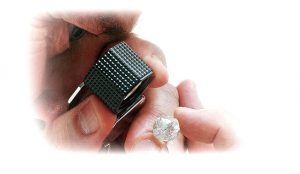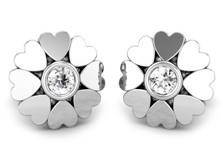Brilliant – use in jewelry
 A diamond is a gem that does not require a separate presentation. Not everyone had the opportunity to at least hold it in their hands. But those few who were lucky enough to see his dazzling brilliance, a startling play of light and magical play, forever preserved bright and unforgettable impressions about this stone. By the way, the word “brilliant” in French means exactly that – sparkling, brilliant.
A diamond is a gem that does not require a separate presentation. Not everyone had the opportunity to at least hold it in their hands. But those few who were lucky enough to see his dazzling brilliance, a startling play of light and magical play, forever preserved bright and unforgettable impressions about this stone. By the way, the word “brilliant” in French means exactly that – sparkling, brilliant.
Diamonds are made from diamonds (from the Arabic “almas” – indestructible) – minerals that are a form of carbon. This stone is the hardest among all the known minerals on the planet, but at the same time the most fragile. When they talk about the hardness of a diamond, they mean exactly the properties associated with its high density, that is, if you try to squeeze it hard, it will remain intact. But if you strike it with something heavy and hard, like a hammer, then the diamond is more likely to crack or crack.
A diamond can be made far from every diamond, since most of these stones are too small and hard to cut. Industrially significant birthplaces are located mainly in Australia, Russia, Canada, and South Africa, where minerals suitable for further processing are mined.
The first diamond record dates back to about the 4th millennium BC. e. At that time in India, the stone was considered a sacred and magical object, and no shape was given to it.
Only in the XIII century, it was found that even a simple polishing can give a diamond an attractive look and reveal its amazing properties. But, in spite of this discovery, the diamond has not been processed for a long time, considering that the stone loses all its magic power from this.
The first mention of a diamond as a cut diamond dates back to 1463, when a certain Ludwig van Berkem – a Flemish grinder at the court of Charles the Bold, an influential Duke of Burgundy – using the shape of a “double Dutch rose” shaped the diamond and repaired it so that stone magically transformed and opened its fantastic properties to the human eye. The faceted diamond radiated bright and pure white light, glittered and shimmered in the rays of sunlight with a dazzling brilliance.
This magnificent diamond, later named “Sancy”, over time did not lose its magical beauty and remains unchanged to this day. Among its owners were historical figures such as Henry III, Louis XIV and his successors, the English kings James I and James II, as well as the well-known Russian industrialist Pavel Demidov. Currently, the stone is stored in the Louvre Museum.
Since then, diamond cutting has gained popularity and has become ubiquitous, and the stone itself has received the status of “precious.” However, at first they were primitive types of processing. The diamond cutters tried to shape the diamond so that the light, reflecting from its inner edges, would be “locked” inside the stone, giving it a magical shine, dazzling brilliance and fascinating play of color.
In 1961, Arpad Neji, densely occupying
This question was invented, a new type of cut was invented, called the “princess”.
It was she who became the most popular at the time.
Diamond Types
Some mistakenly believe that a diamond can only be white, and colored stones have other names. This is not entirely true, because diamonds are faceted diamonds, while diamonds, in turn, can be colorless (white), yellow, brown, green, blue, pink
mi, red and even black.
Thus, the famous Hope Diamond has a rare sapphire color, and the Tiffany diamond, cut in Paris, is lemon yellow. The diamond “Orlov”, which has decorated the scepter of Catherine the Great since 1784, has a greenish tide. In fact, all these stones are diamonds, since they have been processed and polished, although jewelers still prefer to call them diamonds.
Jewelry can be made using diamond substitutes – cubic zirconia (cubically stabilized).
zirconium), strontium titanate, murmanite (carborundum) and some other minerals. Of course, the buyer should always know what he is buying.
How to evaluate diamond quality
The quality of a cut diamond is evaluated by four main parameters, the so-called “4C” system, which includes:
– Color (Color);
– Clarity;
– Cut (Cut Quality);
– Carat Weight (carat weight).
The weight of the diamond plays a secondary role, rather, and affects, first of all, its estimated value. At the same time, such parameters of a diamond as color, clarity and quality of cut are already indicative of some degree of perfection of a cut diamond.




